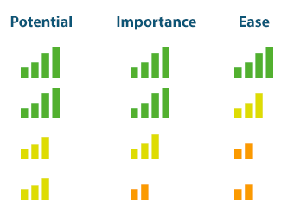Before you can start any testing on your ecommerce site, you need to clarify your goals. Setting the right goals is the first step to making any improvements.
There’s a saying, “Whatever you measure grows.” So, make sure you measure the right thing.
Goals may seem like the obvious part. After all, you already know you want more sales, right? But there’s more to goal setting than just deciding to try and increase your sales.
The Goals Waterfall
Your goals for your conversion-optimization tests should flow from your marketing goals, which ultimately flow from the organization’s overall goals and strategy. This top-down goal flow is what I call the goals waterfall.

The goals from optimization testing should follow from a company’s overall goals and strategy.
Your business goals should determine your website goals, which should be prioritized to determine your leading conversion optimization goal.
The conversion optimization goal for any test should be selected based on how well it supports the website’s goals. This is often an area where there’s confusion about what are the priority metrics to improve. Don’t get off track by following website goals that don’t support marketing goals. For example, I’ve written previously about why it can be dangerous to try to reduce your bounce rate.
Prioritize Goals
Most sites will have several key goals, so you’ll need to prioritize them. You can do this in three steps.
- Rank your goals in terms of their relative value to your business. Here is a typical list of website goals that has been sorted in order of importance for this particular website.

A list of potential website goals.
- Assign relative goal values. The values don’t have to be absolutely accurate revenue-producing numbers to begin. Pick a median goal on your list, and assign it an arbitrary amount, such as $10, and then estimate the relative value of goals above and below it.

Assigning values to goals.
- Estimate actual goal values. Now, to get even better results, you can refine these relative numbers with whatever hard data you have, such as average order value, lifetime value of a customer, or the close rate and value your sales team sees when following up on quote requests. Don’t worry about 100 percent accuracy. It’s better to start testing with relatively firm numbers than to delay until everything’s perfect.

Estimating actual goal values.
Tracking Your Goals
Once you’ve identified your most important conversion goal for your experiment, make sure you track it — and your other key goals — in your web analytics software. Goals are a crucial part of your web analytics setup. If you don’t have keys goals in place, you’re missing out on half the value of your various reports.
That means translating your testing goal into a technical goal trigger that will be tracked by the analytics and testing tools you’re using. The goal you track must be represented by a specific action the visitor takes on the website, like a button click or a visit to a page. Think about an action on the site that the visitors will do only once they have completed the goal.
The key is that it should be an action as close to revenue as possible. So, if your goal is to sell a product, you should track a post-sale “thank you” page as the goal trigger. (If you also accept phone orders, you may need to tackle some advanced tracking techniques to get reliable test results.)
Goals with values attached to them, as explained above, are the only way to find your most valuable visitors; they’re crucial for effective conversion optimization testing.
Be sure to set up ecommerce revenue tracking as well. Increasing average order value can be just as effective as boosting your sales conversion rate, and you’ll want to be able to include that in your results analysis.
At WiderFunnel, we’ve seen test variations that increase conversion rates actually decrease total revenue per visitor and some under-performers in conversions increase revenue. Though, in most cases, revenue and conversion rate are aligned.
A Single Goal
Web analytics tools can provide a ton of information, and it’s not uncommon for ecommerce sites to have a handful of key performance indicators. For example, you may track time on page and the add-to-cart rate. (See “21 Key Performance Indicators for Ecommerce Businesses” for more.)
But when it comes to conversion optimization A/B testing, it’s important to focus on only the revenue-producing goals or goals for each test. Always make sure you are tracking revenue for each test variation. Otherwise, you could pick a conversion rate winner that inadvertently sells lower-value products.
After all, if you’re testing secondary goals and, for example, one variation doubles your add-to-cart rate but lowers your overall revenue, would you still call that variation a winner? Of course not. Revenue trumps other goals. You need to follow the money.
Here’s a real-life example. In one test we ran for WineExpress.com, the winning variation lifted the sales conversion rate by 5 percent. That’s a good result. But when we looked at the revenue generated by each variation, we learned the winning challenger actually lifted revenue by 41 percent. That’s even better.
So, that variation increased average order value, along with increasing the sale conversion rate. That kind of result leads to even more interesting questions about why it happened. What was it with that variation that caused the higher orders? We can take that potential insight and run follow-up tests in the same vein to learn more.
So, track revenue-producing goals for your A/B tests, but those other goals are still useful too. While not all web analytics goals are the best for A/B testing, they still may be helpful to generate hypotheses and explore new testing opportunities.
By paying attention to secondary goals, you can discover new testing avenues that help you get even more value from your ecommerce website.
Track as many goals and actions as you can with your web analytics tools so you can be free to explore your visitors’ behavior. Within web analytics is where you can do freeform exploration to generate ideas or hypotheses for your A/B tests. Then, validate those ideas through revenue-tracking controlled tests.





